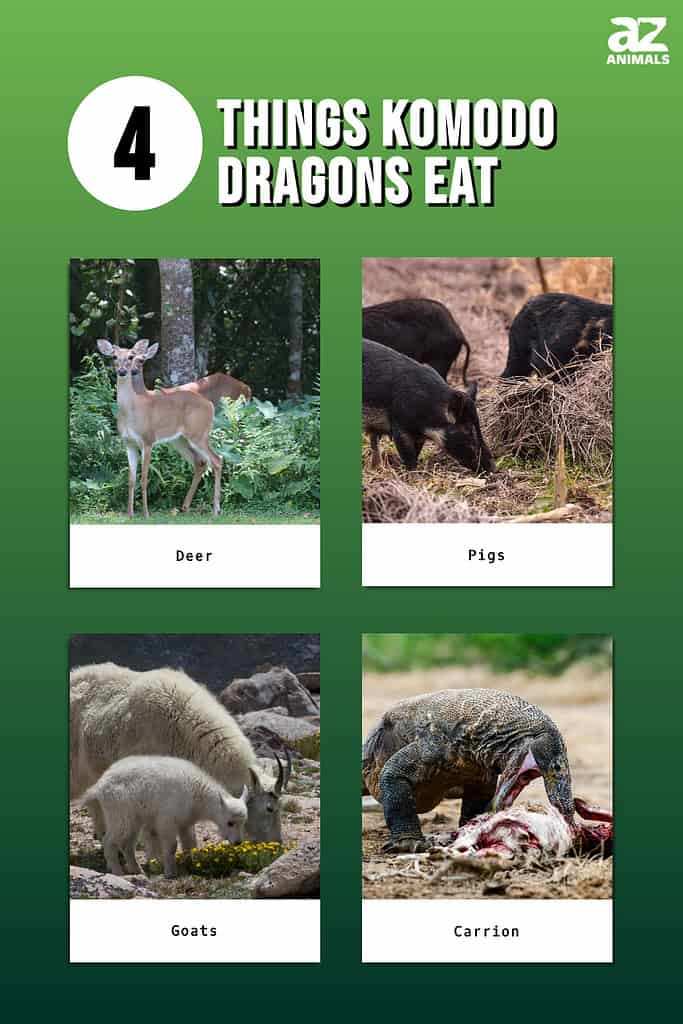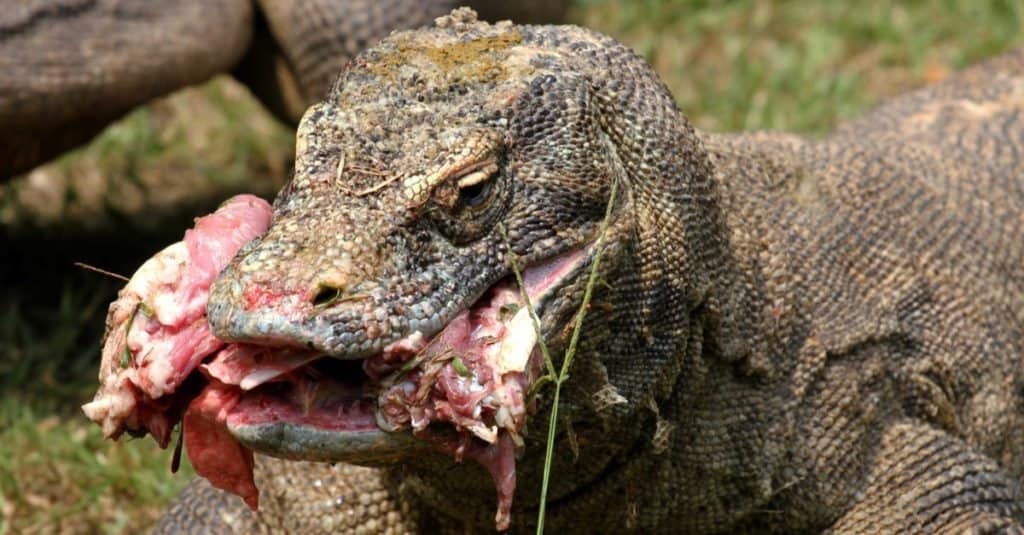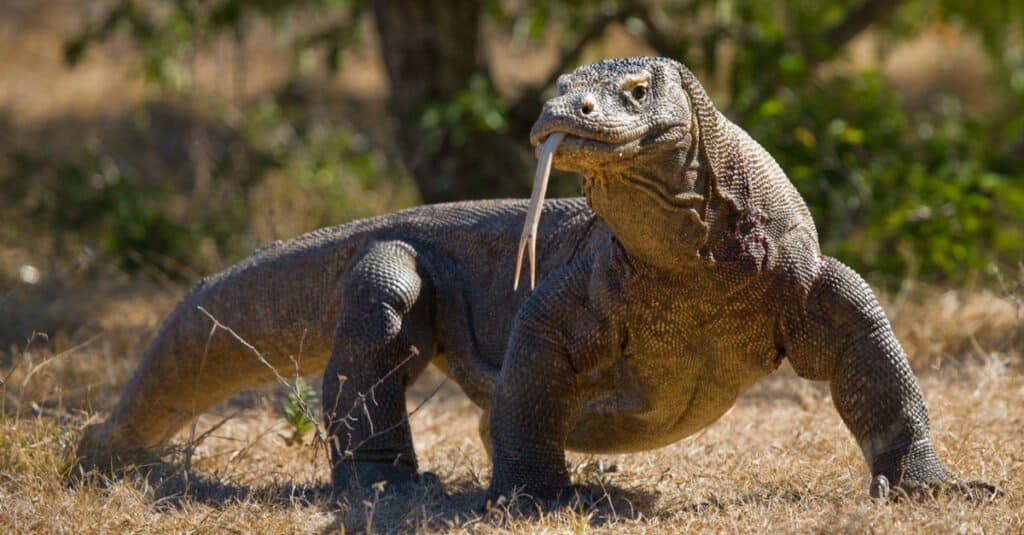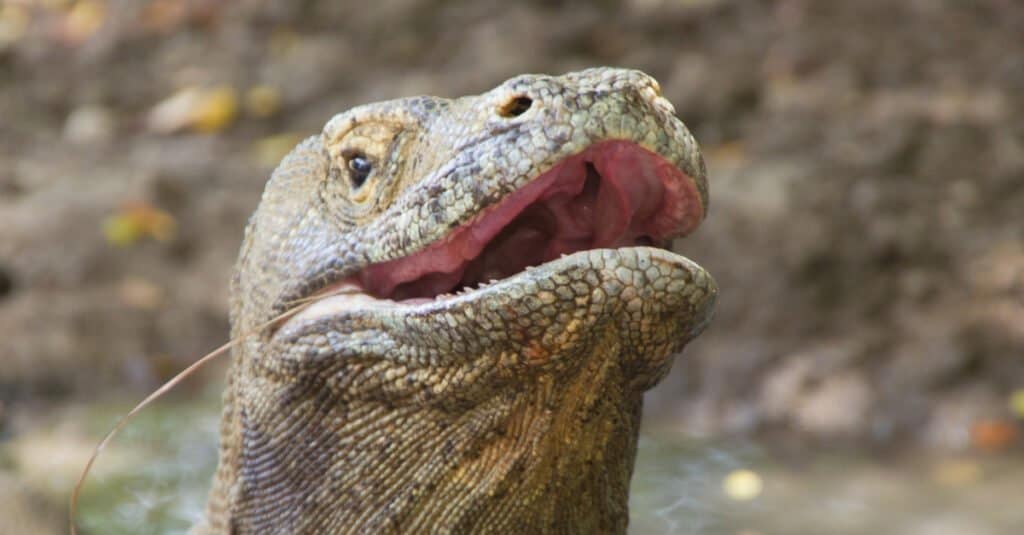
Komodo dragons are carnivores and highly efficient predators with the ability to hunt and consume a wide variety of foods. However, the scientific study of this species has revealed quite a bit about what the Komodo dragon eats. Research into the diet of the Komodo dragon is still uncovering added information, some of which may surprise you!
The Komodo dragon is the largest known lizard in the world. They evolved in isolation in the islands around the Indonesian archipelago. The species was undisturbed until its eventual discovery by the Western world during the first World War. The Komodo dragon is a species of monitor lizard. In addition to being the largest lizard in the world, it is known to be one of the most aggressive.
The Komodo dragon’s evolution spans millions of years with little interruption. This allowed the species to develop some highly impressive adaptations. These adaptations make the Komodo dragon a highly effective predator. An adult dragon is so powerful that it can hunt and kill other animals over twice its size!
What Does The Komodo Dragon Eat?

The Komodo dragon is a consummate carnivore, and its diet consists primarily of meat and includes animals such as deer, goats, and pigs. This species prefers to hunt live prey. However, they are such voracious eaters that they will also consume any dead animals they come across as well. The Komodo dragon is huge, able to grow up to three meters long, and reach up to 330 pounds in weight. The largest Komodo dragon weighed an impressive 365 pounds!
Experts hypothesize that the Komodo dragon evolved to be so large in response to sharing its habitat with large prey such as mammals. Currently, the sheer power and size of this species allow it to hunt and kill animals much larger than itself.
Summary of What Komodo Dragons Eat
Here is a full list of things Komodo dragons most commonly eat:
| Rank | Animals |
|---|---|
| 1 | Deer |
| 2 | Pigs |
| 3 | Goats |
| 4 | Carrion |
| BONUS | Animal Carcasses (opportunistic eating) |
A Complete List Of Foods The Komodo Dragon Eats

Komodo dragons will hunt each other. Large Komodo dragons eat dead and live members of their species.
©Sergey Uryadnikov/Shutterstock.com
The Komodo dragon is a solitary species of monitor lizard and is an opportunistic hunter. They will hunt and kill anything that crosses their path. This includes both living and dead members of their species and humans. While Komodo dragons do not hunt together, they have been spotted in small groups gathered around one carcass.
Prey selection is dependent on the Komodo dragon’s size. Large adult Komodo dragons prefer to hunt the large mammals that were introduced to their natural habitat by men. These are animals such as pigs, dogs, goats, deer, horses, and water buffalo. Prey that is indigenous to their habitat includes small rodents, deer, wild boar, and monkeys. They will also eat dead animals, as well as other Komodo dragons. Smaller adult dragons will consume insects, smaller lizards, rodents, birds, and snakes.
Additionally, large Komodo dragons will cannibalize their smaller counterparts. They will actively hunt them in the same manner as any other prey. Komodo dragons are also adept climbers and will hunt in trees to find food. The smaller members of the species are most likely to climb to catch prey while avoiding larger dragons. Large dragons refrain from climbing to hunt, preferring the larger mammals on the ground.
How Much Food Do They Eat?

What do Komodo Dragons eat? Whatever shows up!
©Yudi S/Shutterstock.com
Komodo dragons seek out prey consistently, and most of their time is spent looking for food. However, they can go for several hours without food while hunting. This is due to their ability to consume substantial amounts of food at one time. The species’ sharp and serrated teeth and lack of molars mean the Komodo dragon cannot chew their food. Primarily, they are used to rip bits of meat off a carcass in manageable bites. These pieces are propelled to the back of the mouth and swallowed in whole chunks.
The species has a stomach that can expand when needed. This physical adaptation allows them to consume up to 80 percent of their body weight. A large Komodo dragon may reach up to 150kg (330 lbs) in weight. This means it would be capable of consuming an impressive 120kg (265 lbs) of meat in one meal!
Baby Komodo Dragons Have To Be Careful
Newly hatched Komodo dragons are called pups. Currently, there is no evidence that they receive parental care from the female after the 9-month incubation and hatching period. The juvenile pups begin hunting on their own immediately after hatching. They feed on the same prey smaller adult Komodo dragons consume. This begins with insects and progresses to smaller animals like lizards and birds.
Additionally, juvenile Komodo dragons are at risk of being consumed by larger members of their species. To avoid being eaten, these juveniles will often roll in the fecal matter of larger dragons. They do this to cover their scent and avoid detection. When in a feeding circle, smaller lizards will adopt appeasement strategies. They do so by using a ritualized walk of exaggerated side-to-side steps. The strategy also involves holding their tails straight out to avoid an attack.
Does The Komodo Dragon’s Diet Change By Season?

Komodo dragons live in tropical climates, and they don’t change the way they eat based on time of year.
©Midori; derivative work: WolfmanSF, CC BY-SA 2.1 JP – License
The Komodo dragon does not experience much change in its diet. This is largely due to their ability to consume virtually any type of prey. This is the primary reason for their status as the tertiary predator of their habitat. This species is found in the tropical savannah forests of the Indonesian islands. As such, it does not experience drastic temperature changes due to changing seasons.
Do Komodo Dragons Have Any Natural Predators?
As the largest and most dangerous predator in its habitat, the Komodo dragon has no natural predators of other species. However, the dragon is cannibalistic and larger members of the species will hunt smaller members. Within their natural habitat, they are at the top of the environmental food chain.
Fossils have been discovered recently that suggest how they got this distinction. The fossils may indicate that the Komodo dragon evolved in response to the presence of large land mammals. The fossils indicate the presence of prehistoric mammals that appear similar to modern elephants. Experts are examining the possibility that the Komodo dragon adapted by getting larger too.
The sheer size of the Komodo dragon makes it a formidable predator. This and other adaptations allowed them to take the top spot as the tertiary predator within their environment.
How Does Their Diet Impact Other Species?
Komodo dragons have a voracious appetite, and their diet impacts all animal species within their environment in the Indonesian islands. This species is classified as a tertiary predator because they are the largest and most deadly carnivore in its habitat.
Predatory animals found in the same habitat are the Timor python, feral dogs, and Javan spitting cobra. The blue-lipped sea krait, Russel’s viper, and the white-bellied sea eagle also share its habitat. The extremely rare Flores hawk-eagle is sometimes found in the same location as well.
Historically, the saltwater crocodile was a competitive predator. It lived in the coastal areas and mangrove swamps within the Komodo State Park habitat as well. However, this species is now extinct within this area.
These smaller predators are no threat to the fully grown Komodo dragon and compete with the smaller juveniles for prey.
How Does The Komodo Dragon Hunt?

Komodo dragons rely on their tongues to find food, and scent the air with them the same way snake species do!
©GUDKOV ANDREY/Shutterstock.com
The Komodo dragon’s hunting strategy relies on stealth and power. They are capable of spending hours in one spot on a game trail waiting for passing prey. When a sizable victim crosses their path, they ambush the prey. Then they use their powerful jaws and serrated teeth to deliver a devastating bite.
Additionally, the Komodo dragon saliva is known to have over fifty diverse types of infectious bacteria. Researchers have also found that Komodo dragons have venom glands in the mouth. When prey receives a Komodo dragon bite, it sometimes manages to escape. However, the resulting bacterial infection and venom often result in death within four days.
Like other monitor lizards, the Komodo dragon has keen eyesight. Their vision is specifically adapted to detect movement, and they can see objects up to 985 feet away. However, this species does not rely on its eyesight to detect prey. It also has extremely poor hearing in comparison to humans.
The Komodo dragon relies primarily on its advanced sense of smell to detect prey. Like snakes, the Komodo dragon uses its forked yellow tongue to sample air. Then the tongue retracts into the mouth to press on the Jacobson organs located on the top palate. Using these chemical analyzers, the Komodo dragon can distinguish small prey from larger and more desirable prey.
This heightened sense of smell also helps the Komodo dragon track prey they have bitten that escapes. It also helps the dragon in finding carrion to consume. They are also able to use scent to track down prey that has been bitten by other Komodo dragons.
What is the Biggest Thing a Komodo Dragon Can Eat?
Komodo dragons start out as young hatchlings eating insects and small lizards, but as they grow, they move on to larger prey such as rats, birds, goats, pigs, deer, and even smaller komodo dragons. The biggest things they hunt are horses and water buffalo. In addition to larger animals, they also include insects, rats, rabbits, mice, and other carnivore items. Komodos are opportunistic and can reach speeds of up to 11 mph. Rather than chasing prey, they use ambush tactics by hiding in tall grass or shrubs next to trails or slowly sneaking up on their prey. They will attack any living creature of any size, including humans.
Komodo Dragons are considered apex predators because of their impressive size and strength. In addition to their large size, they have the unique ability to swallow an animal that is nearly equal in weight to themselves in one sitting. This has been witnessed multiple times, such as when a 101-pound Komodo Dragon was observed devouring a 90-pound wild pig without leaving any remains behind. Another case reported that a 110-pound dragon consumed an even larger 68-pound pig within 17 minutes! It’s no wonder why these animals are top predators on the island of Komodo – with such power and efficiency. It’s hard for other species to compete against them.
Are Komodo Dragons Dangerous to Humans?

Komodo dragons are man-eaters and will hunt and attempt to kill humans. They are very dangerous, and even captive Komodo dragons have brutally attacked humans!
©vladivlad/Shutterstock.com
Komodo dragons are highly dangerous animals. They should never be approached in the wild or while in captivity by anyone other than a highly trained professional. This species is one of the few classifieds as man-eaters. They will hunt and kill a human being as readily as any other form of prey. There have been quite a few accounts of people being ambushed, bitten, and actively hunted down by Komodo dragons.
Additionally, individuals have been brutally attacked by captive Komodo dragons as well, including trained professionals. The venom and infectious bacteria transferred in the Komodo dragons bite also can kill you. For both the safety of people and the Komodo dragon itself, experts strongly urge the public to stay away. People must avoid this animal and its habitats.
Are Komodo Dragons Endangered?
The Komodo dragon is classified as a Vulnerable species by the ICUN. This is due to hunting and loss of natural habitat, as well as a decreased level of available prey. This species faces the increased threat of extinction shortly. There are only an estimated 3,000 to 5,000 Komodo dragons left in the remaining volcanic forest locations they call home.
However, the tourism of recent years that has been generated by increased interest in the Komodo dragon has helped raise awareness. This awareness has sparked new vitality, and efforts to preserve this species and what remains of its habitat have increased.
The photo featured at the top of this post is © Sergey Uryadnikov/Shutterstock.com
Thank you for reading! Have some feedback for us? Contact the AZ Animals editorial team.






